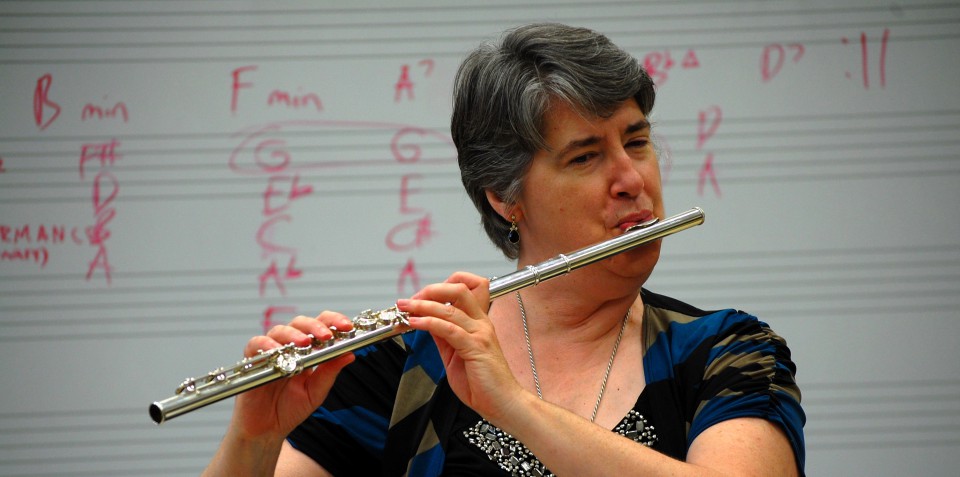Have you ever seen flute players holding their flutes like this?
How about this?
Were you aware that both of these right hand positions have many negative consequences for students and how they can contribute to the flute section of your ensemble? These consequences can include poor tone, poor intonation, and slow and/or uneven technique. In some cases, hand positions like this can lead to physical problems like tendinitis, carpal tunnel syndrome and other repetitive strain injuries.
If you recall, in an earlier post from last school year, we examined the issue of balancing the flute in our hands rather than holding it. Take a look at the banner photo on this blog and you will see how I accomplish this. If you were looking from the bottom end of the flute, the rods should be at about 11:00, with the mechanism pointing slightly forward. That way, the flute can rest on the right thumb, with the little finger on the Eb key as a counter-balance. My right hand is behind the flute and I am able to move my fingers freely from the joints at the base of my fingers. It is also important that my wrist is relaxed and in a neutral position, not canted to one side or the other.
Let’s examine the issues in the first photo:
- The rods of the flute are pointing straight back at about 3:00
- The student’s thumb is in front of the flute and she is bracing the flute against the base of her fingers so it won’t roll back
- The base of the fingers are against the rods (this is also bad for the flute because dirt and oil can work its way into the mechanism, causing it to bind)
- Her wrist is canted toward the upper end of the flute
- She has a lot of tension in her fingers, thumb, palm, wrist and forearm
If she continues like this, this student will have a lot of trouble developing her technique. Also, her tone is small, covered and flat. The first thing I would do is realign her headjoint so the blow hole is between the keys and the rods. Then she will need to learn to rotate the flute body away from her so she can let the flute rest on her thumb. She will also need to retrain herself so she extends her fingers and learn to move her fingers from the bottom joints rather than the second joints of her fingers.
In the case of the second photo, the alignment of the flute is not so much of a problem, though it can probably be adjusted slightly. The problem lies in what she is doing with her right thumb. There are lots of kids with so-called hitchhiker thumbs. This hand position is seriously impacting her ability to develop her technique. She’s also putting a lot of strain on both joints of the thumb. In some cases I have seen that this can lead to repetitive strain injuries. The solution is to teach the student to rotate the thumb so the flute is resting on the side of the thumb, by the fingernail and extending the fingers so it is more like holding a ball or a sandwich. Once she can learn to move her fingers from the base joints, she will quickly acquire facility in her technique.
If you find these entries helpful, subscribe, share with your colleagues and come back regularly for more flute tips. Please comment and feel free to ask questions. What do you want to know about flute pedagogy? Maybe the answer to your question will be the next flute tip. Find me on Facebook or email me your questions at dr_cate@sbcglobal.net. For information about clinics and workshops click here.



Why do you continually use the pronoun “she” when discussing flute players? Instruments do not have gender identities, and although many flute players may be female, it’s offensive to the male ones. I would consider sharing your articles on my band page, but I won’t because I have a male flute player, and I won’t advocate your stereotyping. I know some fantastic female tuba players, and I would feel the same way about a tuba article using “he”. Thank you for your time, and I hope you consider using “they” or “he/she”:
LikeLike
The only reason I used the female pronoun in this post was because the photos were of girls and I was speaking of the specific issues with these particular students. There was no gender bias intended in any way. I have many boys in my studio and see similar issues regardless of gender. If you are willing to take the time to look at my other posts, you will see that I generally do not mention gender designations in my posts. I refer to students, kids, flute players, etc.
LikeLike
Pingback: Gadgets and Gizmos | Dr. Cate's Flute Tips
Pingback: Being the Flute Police | Dr. Cate's Flute Tips
Pingback: Transitioning to Open Holes | Dr. Cate's Flute Tips
Pingback: Solutions for Common Third Octave Problems | Dr. Cate's Flute Tips
Pingback: Building Flute Technique | Dr. Cate's Flute Tips
Pingback: Building Technique | Dr. Cate's Flute Tips
Pingback: Three Essential Skills | Dr. Cate's Flute Tips
Pingback: You Wouldn’t Think it Makes Much Difference But…….. | Dr. Cate's Flute Tips
Pingback: The Secret of Tuning Up Db (C#) | Dr. Cate's Flute Tips
Pingback: The Antidote for Fake-arando | Dr. Cate's Flute Tips